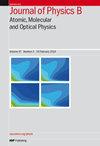Separation of kinetic rate orders in extreme ultraviolet transient grating spectroscopy
IF 1.5
4区 物理与天体物理
Q3 OPTICS
Journal of Physics B: Atomic, Molecular and Optical Physics
Pub Date : 2024-04-23
DOI:10.1088/1361-6455/ad421f
引用次数: 0
Abstract
We present an Extreme Ultraviolet (EUV) transient grating (TG) experiment of the spinel Co3O4 compound using tuneable incident energies across the Co M2,3-edge and a 395 nm probe pulse, detecting both the first and the second diffraction orders. While the first diffraction order shows a monotonous behaviour as a function of time, with a sharp response at t=0, followed by a weak sub-picosecond component and a nearly constant signal thereafter, the time dependence of second diffraction order varies dramatically with the incident energy as it is tuned across the Co M-edge, with the appearance of a component at t>1 ps that grows with increasing energy. The results are rationalised in terms of the deviations of the initial grating from sinusoidal to non-sinusoidal, namely a flattening of the grating pattern, that introduces new Fourier components. These deviations are due to higher order, three-body terms in the population relaxation kinetics. These results highlight the use of the response of the second diffraction order in EUV TG as a tool to identify higher order terms in the population kinetics.分离极紫外瞬态光栅光谱中的动力学速率阶次
我们介绍了一项针对尖晶石 Co3O4 化合物的极紫外(EUV)瞬态光栅(TG)实验,该实验使用了跨越 Co M2,3- 边的可调入射能量和 395 nm 的探针脉冲,同时检测了第一和第二衍射阶。第一衍射阶随时间的变化表现出单调的特性,在 t=0 时有一个尖锐的响应,随后是一个微弱的亚皮秒分量,之后信号几乎保持不变,而第二衍射阶的时间依赖性则随入射能量的变化而剧烈变化,因为它在 Co M-edge 上的入射能量是可调的,在 t>1 ps 时出现一个分量,随着能量的增加而增加。从初始光栅从正弦到非正弦的偏差(即光栅图案的扁平化)来看,这些结果是合理的,因为它引入了新的傅立叶分量。这些偏差是由于种群弛豫动力学中的高阶三体项造成的。这些结果突显了在 EUV TG 中使用第二衍射阶响应作为工具来识别群体动力学中的高阶项。
本文章由计算机程序翻译,如有差异,请以英文原文为准。
求助全文
约1分钟内获得全文
求助全文
来源期刊
CiteScore
3.60
自引率
6.20%
发文量
182
审稿时长
2.8 months
期刊介绍:
Published twice-monthly (24 issues per year), Journal of Physics B: Atomic, Molecular and Optical Physics covers the study of atoms, ions, molecules and clusters, and their structure and interactions with particles, photons or fields. The journal also publishes articles dealing with those aspects of spectroscopy, quantum optics and non-linear optics, laser physics, astrophysics, plasma physics, chemical physics, optical cooling and trapping and other investigations where the objects of study are the elementary atomic, ionic or molecular properties of processes.

 求助内容:
求助内容: 应助结果提醒方式:
应助结果提醒方式:


